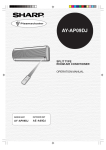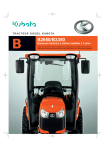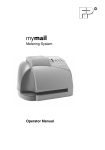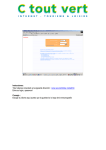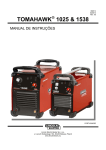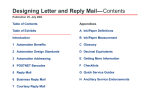Download Simplicity TP-1234 Specifications
Transcript
TM OWNER’S OPERATION AND MAINTENANCE MANUAL OF THE MAK SPUTTERING SOURCES 5830 Hellyer Avenue San Jose, CA 95138 PH: (408) 362.1000 FX: (408) 362.1010 E-MAIL: [email protected] YOUR S/N _____________________________ WARNING AS WITH ALL ELECTRICAL DEVICES, THERE IS A SHOCK HAZARD ASSOCIATED WITH THIS DEVICE. ALL INSTRUCTIONS SHOULD BE FOLLOWED PERTAINING TO THE USE OF SUITABLE INTERLOCKS ON ALL POWER SUPPLIES TO BE USED TO POWER THIS PRODUCT. Issued September 11, 2008 Precautions to assure the proper operation of your MAK Source • Water MUST be flowing thru the MAK while sputtering. Please see O&M manual for flow requirements. CAUTION If MAK has been operated without water --- DO NOT turn the water on --- allow the MAK to cool down before turning water on. • Target paste [supplied with MAK] MUST be used. This provides a thermal layer between the target and cathode [Copper block]. It is required to protect against uneven or irregular surfaces of the target and / or cathode. CAUTION Failure to use target paste can damage the MAK. A VERY SMALL AMOUNT MUST BE APPLIED -- A GLOVED FINGER USED TO SPREAD EVENLY OVER THE CATHODE BLOCK. The block should be clearly visible --- thru a thin gray film. NOTE: A substitute paste such as thin [0.005”] Indium foil can also be used. • A keeper MUST be used for all targets --- including magnetic. The keeper is used for centering the target and maintaining a continuous magnetic path. • Ceramic or Oxide targets --- MUST --- be bonded to a copper backing plate that contains a keeper. • MAK Sputter Sources should be CLEANED on a routine basis. This is easily accomplished during target change. 1. With target removed, clean entire cathode assembly --- removing any foreign material present. Cleaning of both inside and outside of the block is suggested. 2. Clean the anode shield. Issued September 11, 2008 2 Table of Contents Introducing US, a Division of MeiVac, Inc............................................................................................ 4 MeiVac, Inc. QUALITY ASSURANCE .................................................................................................... 4 Introducing MAK Sputter Sources........................................................................................................ 4 Magnetron Sputtering?.......................................................................................................................... 5 RF Sputtering.......................................................................................................................................... 7 Operation of the MAK ............................................................................................................................ 8 VACUUM SYSTEMS……………………………………………………………………………………………………………9 Installation of Sources......................................................................................................................... 10 Power Hook-up ..................................................................................................................................... 12 DC CONNECTION………………………………………………………………………………………………………….. 12 RF CONNECTION……………………………………………………………………………………………………………12 Target Parameters................................................................................................................................ 14 PURITY………………………………………………………………………………………………………………………14 SURFACE…………………………………………………………………………………………………………………….14 TARGET DIMENSIONS……………………………………………………………………………………………………….14 TARGET SUPPLIERS…………………………………………………………………………………………………………14 MACHINABLE MATERIALS……………………………………………………………………………………………………15 NON-MACHINABLE MATERIALS……………………………………………………………………………………………...16 Target Mounting……………………………………………………………………………………………….. 16 Rate vs. Power…………………………………………………………………………………………………..18 Relative Sputtering Rates of 50 Materials………………………………………………………………….18 Relative Rates of Sputtering Sources vs. Distance……………………………………………………… 19 Returns & Warranty.............................................................................................................................. 20 APPENDIX A: MAK TECHNICAL SPECIFICATIONS .......................................................................... 21 APPENDIX B: TARGET SUPPLIERS ................................................................................................... 23 TARGET DIMENSIONS 1.3" 2.0" 3.0" 4.0" 6.0" SPARE PARTS 2.0" 3.0" 4.0" 6.0" TUTORIALS Issued September 11, 2008 1.3" {Benefits} {Simplicity} {TargetMounting} 3 INTRODUCING US, a Division of MeiVac, Inc. US has been an innovative manufacturer of sputtering since 1977. Exclusive licenses were obtained from Stanford University and Lawrence Livermore Laboratory to build and distribute their patented magnetron sputtering sources on a worldwide basis. MeiVac, Inc. QUALITY ASSURANCE All MeiVac products are manufactured under the most stringent conditions. This includes proper selection & inspection of original materials, assembly in clean environments, and complete testing for leaks & functionality. These quality products are packaged in durable containers for shipment throughout the world. INTRODUCING MAK SPUTTER SOURCES The MAK sputter sources were designed, developed & tested under controlled laboratory conditions at a major United States government laboratory. This low cost planar magnetron sputtering source is compact, easy to install and requires no target bonding. All of the MAK sputter sources (1.3, 2, 3, 4, and 6 inch) provide shielded electrical paths which allow RF as well as DC power to the cathode with minimum line losses and low reflection of RF power. The MAK sputter source has a unique feature of allowing low operational pressures (0.5 millitorr) as well as high operational pressures (600 millitorr) without losing the focused plasma to the target. The MAK sputter source is available in non-UHV and UHV designs. Issued September 11, 2008 4 MAGNETRON SPUTTERING Observations of the phenomenon we now call sputtering, go back over one hundred years to early experiments which introduced electricity into a reduced pressure atmosphere. L. Holland describes these beginnings in his book Vacuum Deposition of Thin Films. “When an electrical discharge is passed between electrodes at a low gas pressure, the cathode electrode is slowly disintegrated under the bombardment of the ionized gas molecules. This phenomenon is termed cathodic sputtering. The disintegrated material leaves the electrode surface either as free atoms or in chemical combination with the residual gas molecules. Some of the liberated atoms are condensed on surfaces surrounding the cathode while the remainder are returned to the cathode by collision with gas molecules.” The ensuing process might be compared to a fine sand blasting in which the momentum of the bombarding particles is more important than their charge. The inert gas argon was chosen, to act as the sputtering medium, because it is a heavy rare gas and is plentiful. It also has a low ionization potential. The inert nature of argon inhibits compounds from being formed at the target surface. Once sputtered, the target atoms travel until they reach a nearby surface most notably, the substrate. The deposited layer forms or grows on the substrate structure, influenced by such things as material, temperature and gas structure. When the ions strike the target, their primary electrical charge is neutralized (gain back the lost electron) and they return to the process as atoms. Thus, direct current sources generally prevail as the electrical energy source. Issued September 11, 2008 5 In order to increase sputtering rate, magnetic coils were sometimes placed around the chamber to pinch the plasma during the deposition. The pressure was reduced to 20 microns (2 X 10-2 torr) and the rates increased. The electrodes were close together and the R.F. voltage was high. These conditions caused damage to semiconductor devices due to the high electron and secondary ion bombardment, which took place. When it was realized how important the role of a magnetic field was in concentrating the plasma and the effects that it had on rate, sputtering became more attractive as a commercial process. Several magnetic configurations were used such as the post cathode, magnetically enhanced hollow cathodes and magnetrons. In order to make a magnetron work, it is necessary to cause the E X B drift currents to close on themselves. This realization led to the magnetron cathode designs that are in use today. MAK BENEFITS BENEFITS OF THE MAK SIMPLICITY IN SPUTTERING Magnetics • • • • Balanced / Unbalanced Magnet array is INTERCHANGEABLE from balanced or unbalanced. Disassembly of source NOT REQUIRED! Cathode Ring Magnet No Magnetic Housing Provides higher magnetic density at target surface Sputters at lower voltage for comparable power levels Standard MAK sputters magnetic material Issued September 11, 2008 Center Magnet Adjustable Anode Set Screws 6 RF SPUTTERING If the target is an insulator, the neutralization process results in a positive charge on the target surface. This charge may grow to the point that the bombarding ions (±) are repelled and the sputtering process will stop. In order to make the process continue the polarity of the target must be reversed to attract enough electrons from the discharge to eliminate the surface charge. In order to attract the electrons and not repeal the ions, the frequency must be high enough to reverse before the direction of the ions are affected. The usual industrial frequency assigned by the FCC for such is in the MHz range. Since this is a “radio” frequency, the process is called radio frequency sputtering, or RF sputtering. Most of the early sputtering was done using direct current sources. This meant high voltage, with current draw being limited by the gas pressure. Typical voltages were 3-5 kV with a current from 50-250 ma at pressures of 50-250 microns. R.F. power was introduced because it makes it possible to sputter insulators. BENEFITS OF THE MAK SIMPLICITY IN SPUTTERING Physical Parameters VACUUM SEAL • • • One Vacuum Seal Elastomer (HV) or Metal (UHV) field interchangeable No water to Vacuum Seal • • • Small Profile Mounts on CF, ISO or installs thru a Quick Disconnect As example, standard 3” MAK fits thru opening of 6” CF Anode Height adjustable to target thickness - Selectively positioning anode to same plane as target --- obviously minimizing material build-up No Mechanical Target Clamp Target surface is not in contact with dissimilar clamping material --- minimizing stress during sputtering and cool down PICTURE SHOWN IS NOT TO SCALE HN CONNECTOR WATER LINES • Teflon water lines with quick disconnects Issued September 11, 2008 • Standard HN power connector permits RF/DC operation 7 OPERATION OF THE MAK VACUUM SYSTEMS To successfully operate the MAK Series, a leak-tight vacuum system must be available. This system should be pumped with a high vacuum pump of the turbo, or a cryo type. It may be necessary to have a throttle valve, or orifice in the system to control pump throughput while the sputtering gas is introduced. If a cryopump is used, the throttle valve may not be required, however, it is desirable if sputtering gas pressures of more than five microns are to be used. The vacuum system should be equipped with suitable gauging to measure and monitor pressures in the 0.5-600 micron range during sputtering, and the 1x10-5 to 1x10-9 torr range during pre-sputter pump down. The system must also be equipped with a fine metering valve and separate in-series shut-off valve used for the introduction of the sputtering gas. A suitable fixture for mounting and holding the substrate(s) during film deposition should be provided, in conjunction with a means of shuttering the source (target) from the substrate during precleaning of the target. Since the MAK Series will not operate properly if the shutter is positioned too close to the target, it is suggested that the total distance from target to shutter be at least 1”. Issued September 11, 2008 8 To obtain ideal uniformity, the distance from source to substrate should be adjustable. Note: The rate will decrease by the square of the distance from source to substrate, however uniformity will be enhanced as this distance is increased. The chamber may be made of glass or metal. If the chamber is metal, a viewing port should be provided for observation during sputtering. Issued September 11, 2008 9 INSTALLATION OF SOURCES STANDARD MOUNTING To mount the source a QUICK COUPLE feedthrough adapter is required. A 0.75” adapter is used for the 1.3”, 2”, and 3”, and 4” sources. The 6” MAK requires a 1.25” quick coupler adapter. Water Lines Power Connector (HN) End Adapter Atmosphere Vacuum Vessel HN Power Pin Tube Clamp Quick Coupler MAK Installed in Vacuum Chamber A. PREPARING THE SOURCE FOR MOUNTING VIA A QUICK COUPLER 1. Loosen the screws on the End Adapter holding the electrical connector on the end of the tube. 2. Pull straight out on the electrical connector mounting assembly. The whole assembly will come off, leaving the water tubes free and the electrical connector assembly unplugged from the power feed rod. 3. Remove the tube clamp from the tube. This clamp is designed to keep the source in position when the system is under vacuum. 4. From the inside of the vacuum system, insert the water tubes into the feedthrough hole, and then insert the tube. Position the tube to the approximate desired source to substrate distance. 5. Slide on the “O” ring, compression ring and coupler nut. Hand tighten the nut. 6. Slide on the clamp tube, position and tighten. Issued September 11, 2008 10 7. Slide the End Adapter on the tube, making sure that the slip pin in the connector body is in- serted in the socket of the power feed rod. Push on as far as it will go and tighten the screws. 8. The system may now be pumped down. 9. Hook up the water lines. Connect the house supply and drain lines to the source tubes. See technical specifications for minimum flow requirements. 10. Connect the power cable. B. DIRECT FLANGE MOUNTING VIA CF, ISO, ANSI, JIS and other flanges 1. MAK Source has been attached to the mounting flange. To adjust source to substrate distance --- either the substrate must be moved or a feedthrough nipple must be placed between the mounting flange and the vacuum system. 2. Attach the MAK mounting flange to the system. 3. Refer to step (7) above. 3” MAK Welded onto Conflat Flange PN: L300A01-CF Issued September 11, 2008 11 POWER HOOK-UP All MAK sputter sources may be operated in either the DC or RF mode. All models are supplied with an HN (Amphenol UG-496/U) for convenient electrical connection to your choice of power source. The following US Sputtering Power Supplies come complete with output cables having the HN mating connector. P/N SU-500 DC P/N SU-1500 DC P/N SU-5000 DC P/N: SU-R301 P/N: SU-R601 P/N: SU-R1001 500 Watt DC Power Supply 1500 Watt DC Power Supply 5000 Watt DC Power Supply 300 Watt RF Generator and Automatic Tuning Network 600 Watt RF Generator and Automatic Tuning Network 1000 Watt RF Generator and Automatic Tuning Network DC Connection The power supply is provided with twelve feet of RG 8/U high voltage cable. Connect the PL 259 connector to the power supply and the HN connector to the sputter source. RF Connection The RF Generator / Automatic Tuning Network is provided with all necessary cables for hook-up. 12’ co-axial cable for connection of the power supply to tuning network 3’ co-axial cable for connection of tuning network to sputter source (HN Connector) 24’ interface cable between network controller and tuning network Four-foot control cable between control panel and RF supply End Adapter HN Connector (Female) HN Connector (Male) Water lines Cable to RF or DC Power Supply Issued September 11, 2008 12 RF Generator Auto Tuning Network D Connector to D Connector Power Connection 50 Pin Connectors with metal covers 12’ RG-8U Cable with N Type Connections Input Power Connection 3’ or 5’ RG 393/U Cable with HN Connector OUTPUT TO SPUTTERING CAUTIONS IN RF HOOK-UP Cable length between should be a derivative of the 13.56 MHz. Wave length. Approximately 48, 24, or 12 feet and be 50 ohm RF shielded cable. Cable length between the tuning network and sputter source should be minimized (3’ or 5’ is recommended for use with US generators). Do not use external grounds at electrical connections; see power supply manual for additional details. Issued September 11, 2008 13 TARGET PARAMETERS Purity Target material for the MAK sputtering source is not confined to a minimum or maximum purity level. This parameter is dependent upon film requirements. Surface The mounting (bottom side) surface of the target should be smooth and flat to allow good contact to source. The top and bottom of the target should be parallel for best deposition uniformity. Target Dimensions See the Target Specifications at www.us-incorp.com. [1.3” MAK] [2.0” MAK] [3.0” MAK] [4.0” MAK] [6.0” MAK] Target Suppliers – For a list of qualified target suppliers, see Appendix B. Simplicity in Sputtering INTRODUCING The MAK Planar Magnetron Sputtering Source Target Installation on the MAK TARGET KEEPER Cathode Target Magnets Issued September 11, 2008 Keeper The MAK sputtering sources have the unique feature of attaching the target using magnetic force. This is accomplished by attaching a magnetically permeable “keeper” (see appendix) to the bottom of the target. This keeper coupling with the magnetic field of the MAK source provides sufficient force to clamp and center the target, eliminating the need for complex mechanical clamps. 14 Machinable Materials The target keeper can be attached to machinable materials by drilling and tapping the target to 90% of it’s thickness and attaching the keeper using a vented flat head screw. TARGET MOUNTING OF THE MAK MACHINABLE MATERIALS By attaching a magnetic keeper to the target, the MAK source uses the magnetics of the gun to hold the target in place. If you have old targets, NO PROBLEM! Drill and tap your existing targets as shown and attach the metallic keeper. Then, snap the target into place. It’s that simple! Target Material Target Material with Drilled and Tapped Hole Target Material with Keeper Mounting Screw Keeper 15 Non-Machinable Materials Ceramic and oxide materials, a copper backing plate containing a magnetic keeper should be used. The target must be bonded to this backing plate and this bond must be able to withstand a temperature of 220oC. TARGET MOUNTING OF THE MAK NON-MACHINABLE MATERIALS Backing Plates Ceramics, oxides, and any other non- machinable targets are commonly bonded to a copper backing plate for all sputtering sources. Cu plate with drilled and tapped hole MAK Backing Plates The MAK sputter source uses the same backing plate, but with a magnetic keeper attached. The keeper holds the target in place without a mechanical clamp. Keeper with screw bond Bonded Target - Example This is an example of a SiO2 target bonded to a copper backing plate with a magnetic keeper attached. target keeper copper backing plate 16 Copper Backing Plate Specifications (See Appendix A) MAK 1.3” Copper Backing Plate Part Number: MAK-130-BP MAK 2” Copper Backing Plate Part Number: MAK-200-BP MAK 3” Copper Backing Plate Part Number: MAK-300-BP MAK 4” Copper Backing Plate Part Number: MAK-400-BP MAK 6” Copper Backing Plate Part Number: MAK-600-BP Caution Failure to use thermal contact paste or a thin metal foil as an interface layer between the target and the copper cooling block can cause over heating and may damage the MAK source and/or target. Simplicity in Sputtering MAK with target installed Target mounted with magnetic keeper Anode retracted Remove the Anode 1. Spread a small amount of thermal contact paste on the top of the copper chill block. The paste should be spread evenly and so thin you can see through it. a) If the thermal contact paste is not used a thermally and electrically conductive foil e.g. indium ~0.005” thick with a donut shape slightly smaller than the cathode/chill block must be placed between the block and the target. b) Place the target at the center of the source assuring that the magnetic keeper has been properly positioned in the recessed center magnet cavity. Twist slightly to evenly distribute the thermal contact paste. c) Replace Anode NOTE: A target keeper is not required with magnetic materials; however, the user should take care to insure even spacing between the O.D. of the target and the I.D. of the ground shield. Thermal Contact Paste Part Number TP-832 17 RATE VS. POWER When gathering rate data, it is also desirable to take rates at different power levels. These values can be plotted to produce a graph similar to the one shown. Please Note: For approximating DC rates, multiply by 1.75. CO PPER 2" Dia., 3" Dist. 40.00 35.00 Å 30.00 / 25.00 s 20.00 e 15.00 c 10.00 5.00 RELATIVE SPUTTERING RATES OF 0.00 50 MATERIALS 0 50 100 150 200 250 300 350 400 450 500 The following list of materials and W atts RF their relative sputtering rates are normalized to copper as 1.00. Copper is a convenient and readily available material to use as a reference. Once the rate of copper is known, then the other 49 may be approximated. Please Note: These rates may vary from those of other periodicals, due to the conditions under which the rates were taken. Element (or compound) Cu = Rate of 1.00 Ag 2.06 Gd 1.17 Rh 0.74 Al 0.73 Ge 1.05 Ru 0.66 Al2O3 0.15 Glass 0.23 Sb 3.68 Au 1.76 Hf 0.67 Si 0.39 Be 0.22 Ir 0.61 SiC 0.36 Bi 10.00 Mg 0.26 SiO 0.27 C 0.05 MgF 0.03 SiO2 0.45 CdS (1010) 2.39 Mn 0.99 Sm 1.14 CdTe 0.64 Mo 0.53 Sn 1.38 Co 0.58 Nb 0.44 Ta 0.43 Cr 0.60 Ni 0.65 Th 0.84 Cu 1.00 Os 0.5 Ti 0.38 Dy 1.18 Pb 3.52 U 0.73 Er 1.00 Pd 1.31 V 0.38 Fe 0.56 Pt 0.9 W 0.39 GaSa (110) 1.70 Rb 4.55 Y 0.95 Re 0.53 Zr 0.65 18 RELATIVE RATES OF SPUTTERING SOURCES VS DISTANCE Rate data, for sputtering with small sources, is usually taken by making step samples and then measuring them with either profilometer or interferometer. A quartz crystal microbalance type rate monitor may also be used. If a rate monitor is used, the geometry and the density of the deposit must be taken into account. Because of the uncertainties of rate monitor data, the most prudent course is to correlate the values taken with the rate monitor with those taken by step sample method. If the distance from the substrate to the target is changed and the power remains constant, the change in deposition rate is a function of the ratio of the distances squared. For example, if the rate at a 3” target to substrate distance is 15 Å/sec., the power is constant and the distance changes from 3” to 4”, the rate drops to 8.4 Å/sec. Rate at 3” = 15 Å/sec., Ratio for a change from 3” to 4” = 32/42 = 9/16 = 0.563 Ratio times Rate at 3” = 0.563 x 15 Å/sec = 8.4 Å/sec Many factors affect deposition rate, but this is a reasonable approximation of the effect of distance. 19 Claims & Returns Shipping and Handling Claims Purchaser should inspect the product carefully as soon as it is received and test it in accordance with any instructions that may be provided. If damage is noted, or the product fails to operate properly as the result of shipping or handling damage, a claim should be filed with the common carrier and a copy forwarded to MeiVac or its distributor. MeiVac or its distributor will not recognize any claim for equipment damaged as a result of shipping or handling damage if the claim is submitted more than thirty days after MeiVac’s or its distributor’s shipment of the product. Failing to report any damage within this period shall be considered an acknowledgement by Purchaser that the product was received undamaged. Warranty Claims For a warranty claim to be valid, it must: • be made within the applicable warranty period, • include the product serial number and a full description of the circumstances giving rise to the claim, and • have been assigned an RMA number (see Authorized Returns) by MeiVac or its distributors. Purchaser’s exclusive remedy and MeiVac’s sole responsibility under the Warranty set forth herein is the repair or replacement of the defective product, at MeiVac’s option. Purchaser shall reimburse MeiVac for the repair of any returned product determined by MeiVac not to be defective or to have been damaged by misuse, abuse or unauthorized repair. All warranty work will be performed at an authorized MeiVac service center. Purchaser is responsible for obtaining authorization (see Authorized Returns) to return any defective units, prepaying the freight costs, and ensuring that the units are returned to the location identified by MeiVac on the RMA. Provided the work required on the unit is covered under the Warranty, MeiVac will replace the affected unit or repair it at no charge to Purchaser. On completion of said repair or replacement, the unit will be returned (freight prepaid) to the Purchaser. Whoever ships the unit (either Purchaser or MeiVac) will be responsible for properly packaging and adequately insuring it. Authorized Returns Before returning any product for any reason, Purchaser shall call MeiVac or its distributor and discuss the reason for return. Be prepared to give the serial number of the unit. This consultation call shall be at no charge to the Purchaser and will allow MeiVac or its distributor to determine if the unit must actually be returned for a problem to be corrected. If it is determined that the unit needs to be returned a Return Material Authorization (RMA) number will be issued. This RMA number must be referenced on all paperwork associated with the return, and be prominently displayed on the outside of any packaging that the unit is being returned in. Units that are returned without MeiVac’s or its distributor’s authorization will be held by MeiVac or its distributor until such time as Purchaser can identify the reason for the return, after which, action deemed appropriate by MeiVac or its distributor (including return of the unit to Purchaser freight collect) shall be taken. Terms governing all products sold by US, a Division of MeiVac are the MeiVac Terms and Conditions of Sale. These can be found on the MeiVac web site (www.meivac.com), the US web site (www.usincorp.com) or obtained from your local representative. 20 Appendix A MAK TECHNICAL SPECIFICATIONS MAK SIZE: MAK 1.3" MAK 2" MAK 3" MAK 4" MAK 6" (33mm) (50.8mm) (76.2mm) (101.6mm) (152.4mm) TARGET mm inch 1.00-5.70 0.040-0.225 1.00-9.50 0.040-0.375 1.00-15.90 0.040-0.625 1.00-19.05 0.040-0.750 2.00-25.40 0.080-1.000 mm inch 1.00-2.54 0.040-0.100 1.00-4.70 0.040-0.187 1.00-6.35 0.404-0.250 1.00-9.50 0.404-0.375 2.00-11.00 0.080-0.437 ccm cu inch 4.90 0.30 19.25 1.17 72.47 4.42 154.00 9.40 463.00 28.25 cm. sq. sq in 8.56 1.33 20.27 3.14 45.60 7.07 81.10 12.56 182.4 28.25 watts 350.00 1000.00 2000.00 3000.00 6000.00 watts 200.00 400.00 750.00 1200.00 2000.00 Max Power DC (Per) cm sq in sq 40.88 263.00 49.30 318.00 43.86 283.00 37.00 240.00 33.00 212.00 Max Power RF (Per) cm sq in sq 24.00 150.00 20.00 130.00 17.00 106.00 15.00 96.00 11.00 70.00 amps 1.00 3.00 5.00 7.00 10.00 200-1000 200-1000 200-1000 200-1000 200-1000 Target Thickness min-max Magnet Target- (1) Thickness min-max Target Volume max Target Surface Area ELECTRICAL Max Power Dc Max Power RF Max Current VOLTAGE Min-Max 21 Appendix A MAK TECHNICAL SPECIFICATIONS COOLING Water Flow at 30psi min. at lowest power level Nominal Water Flow at 60psi for max. power Water Pressure Range MAK 1.3" MAK 2" MAK 3" MAK 4" MAK 6" (33mm) (50.8mm) (76.2mm) (101.6mm) (152.4mm) l/min gal/min 3.48 0.90 3.48 0.90 3.48 0.90 3.48 0.90 7.00 1.840 l/min gal/min 6.20 1.60 6.20 1.60 6.20 1.60 6.20 1.60 12.40 3.20 2.1-5.6 30-80 2.1-5.6 30-80 2.1-5.6 30-80 2.1-5.6 30-80 2.1-5.6 30-80 1/4" OD 3/16" ID 1/4" OD 3/16" ID 1/4" OD 3/16" ID 1/4" OD 3/16" ID 3/8" OD 1/4" ID mm inch 59.70 2.350 59.70 2.350 85.80 3.378 104.80 4.125 170.80 6.725 CF ISO 4-1/2"[DN63] NW 63 4-1/2"[DN 63] NW 63 6"[DN 100] NW 100 6-3/4”[DN125] NW 160 10"[DN200] NW 200 mm inch 19.05 0.75 19.05 0.75 19.05 0.75 19.05 0.75 31.75 1.25 NO YES YES YES YES 1.75 3.85 2.0 4.4 4.0 8.8 5.5 12.1 13.0 28.6 35@200W 100@500W [email protected] [email protected] 145@5KW 5% 6% 8% 8% 7% Bar psi Water Lines Size MECHANICAL Max OD Smallest Mounting Flange Shaft Diameter Anode Adjustable To Target Thickness Weight lbs. kgms. PERFORMANCE Rate For Cu @ 5 mtorr Ar. Target To Substrate = Diameter Of MAK2 Angstrom / Sec UNIFORMITY Substrate Dia. = Source Dia. Target to Substrate = Dia. of Source2 +% (1) Maximum magnetic target thickness is material dependent. (2) Means 2” MAK @ 2” target to substrate 4” MAK @ 4” 22 APPENDIX B TARGET SUPPLIERS ACI Alloys, Inc. 1985 Las Plumas Avenue San Jose, CA 95133 Larry Albert PH: (408) 259-7337 FX: (408) 729-0277 www.acialloys.com SCI Engineered Materials 2839 Charter St. Columbus, OH 43228 PH: (800) 346-6567 FX: (800) 292-8654 www.sciengineeredmaterials.com Cerac, Inc. Box 1178 Milwaukee, WI 53201 Rick Vehlow PH: (414) 289-9800 FX: (414) 289-9805 www.cerac.com Sputtering Target Manufacturing Co. 1005 Corbin Court Westerville, OH 43081 J.R. Gaines PH: (614) 446-2202 FX: (740) 965-5701 www.sputtertarget.com Praxair 16130 Wood Red Road #7 Woodinville, WA 98072 Ron Ekdahl PH: (425) 487-1769 FX: (425) 487-1859 www.praxair.com Tico Titanium 52900 Grand river New Hudson, MI 48165 Mr. J.P. Cruzen PH: (800) 521-4392 FX: (248) 446-1995 www.ticotitanium.com Process Materials, Inc. 5625 Brisa Street, Suite A Livermore, CA 94550 Steve Verley PH: (925) 245.9626 FX: (925) 245.9629 www.processmaterials.com Vacuum Engineering & Materials Co. 131-B Albright Way Los Gatos, CA 95032 Gina Craig Jack Kavanaugh PH: (408) 871-9900 TOLL FREE: (877) 986-8900 FX: (408) 871-2900 www.vacengmat.com SCI Engineered Materials 2839 Charter St. Columbus, OH 43228 PH: (800) 346-6567 FX: (800) 292-8654 www.sciengineeredmaterials.com Williams Advanced Materials 42 Mt. Ebo Road South Brewster, NY 10509 PH: (845) 279-0900 FX: (845) 279-0922 www.williams-adv.com Sputtering Target Manufacturing Co. 1005 Corbin Court Westerville, OH 43081 J.R. Gaines PH: (614) 446-2202 FX: (740) 965-5701 www.sputtertarget.com 23 1.3” MAK US Part Number Description L130-04 Ceramic Ground Shield L130-06 Ring Magnet L130-09 Stainless Steel Ground Shield L130A14 Block Assembly J1200-06 Center Magnet J1200-33 O-Ring J1200-34M Metal Seals J1234-30 Water Lines (2) LL-130-01 Keeper w/ hole & screw (pkg. 10) MAK-130-BP Copper Backing Plate w/ Keeper TP-832 Thermal Contact Paste - 0.5 oz. w/ ferrules 42 2.0” MAK US Part Number Description L200-07 Ring Magnet L200-10 Aluminum Ground Shield L200A14 Block Assembly J1200-06 Center Magnet J1200-33 O-Ring J1200-34M Metal Seals J1234-30 Water Lines (2) LL-200-01 Keeper w/ hole & screw 10) MAK-200-BP Copper Backing Plate w/ Keeper TP-832 Thermal Contact Paste - 0.5 oz. w/ ferrules (pkg. 42 3.0” MAK US Part Number Description L300-10 Aluminum Ground Shield (OLD STYLE MAK SOURCE ONLY) L300-10NT Aluminum Ground Shield L300-13 Center Magnet L300-24 Ring Magnet L300A14 Block Assembly J3400-33 O-Ring J3400-34M Metal Seals J1234-30 Water Lines (2) w/ ferrules LL-300-01 Keeper w/ hole & screw (pkg. 10) MAK-300-BP Copper Backing Plate w/ Keeper TP-832 Thermal Contact Paste - 0.5 oz. 42 4.0” MAK US Part Number Description L400-10 Aluminum Ground Shield L400A20 Center Magnet Assembly L400A14 Block Assembly J4600-13 Center Magnet J4600-32 Ring Magnet Segment each) J3400-33 O-Ring J3400-34M Metal Seals J1234-30 Water Lines (2) LL-400-01 Keeper w/ hole & screw (pkg. 2) MAK-400-BP Copper Backing Plate w/ Keeper TP-832 Thermal Contact Paste - 0.5 oz. (10 @ 31.25 w/ ferrules 42 6.0” MAK US Part Number Description L600-10 Aluminum Ground Shield L600-40 O-ring Magnet Plug L600-41 O-Ring L600A14 Block Assembly L600A20 Center Magnet Assembly J4600-13 Center Magnet J4600-32 Ring Magnet Segments each) L600-42 Water Lines (2) w/ ferrules LL-600-01 Keeper w/ hole & screw (pkg. 2) MAK-600-BP Copper Backing Plate w/ Keeper TP-832 Thermal Contact Paste - 0.5 oz. (16 @ 31.25 42 BENEFITS OF THE MAK SIMPLICITY IN SPUTTERING Water Isolated from: • MAGNETS - NO magnet erosion • POWER - (ALL electrical components) – no power changes due to water resistance – simplifies RF Tuning NO special treatment of water needed • Cooling Channel 1 OF 3 Cathode (Copper) Only small volume above AlN has electrical potential applied, THUS….. • minimizing heated area - facilitating cooling • all components except small cathode area, are at ground or neutral potential • Cathode Cooling Block AlN Magnet Return Passage for Insulated Power Post • • Cooling Block (Copper) Water channel 75% of volume, THUS….. High water flow - maximizing cooling efficiency of copper surface area Water Line Water Line Power Feedthru CATHODE BLOCK - without magnets AlN - Alumina Nitride Excellent: • • Thermal Conductor Electrical Insulator BENEFITS OF THE MAK SIMPLICITY IN SPUTTERING 2 OF 3 Magnetics Cathode • • Ring Magnet Balanced / Unbalanced Magnet array is INTERCHANGEABLE from balanced or unbalanced. Disassembly of source NOT REQUIRED! No Magnetic Housing Provides higher magnetic density at target surface THUS….. – Sputters at lower voltage for comparable power levels – Standard MAK sputters magnetic material Adjustable Anode Set Screws Center Magnet BENEFITS OF THE MAK SIMPLICITY IN SPUTTERING Physical Parameters PICTURE SHOWN IS NOT TO SCALE VACUUM SEAL • • • • 3 OF 3 One Vacuum Seal Elastomer (HV) or Metal (UHV) field interchangeable No water to Vacuum Seal • Small Profile Mounts on CF, ISO or installs thru a Quick Disconnect As example, standard 3” MAK fits thru opening of 6” CF (DN100) • Anode Height adjustable to target thickness Selectively positioning anode to same plane of target--- minimizing material build-up No Mechanical Target Clamp Target surface is not in contact with dissimilar clamping material--minimizing stress during sputtering and cool down (especially for ceramics and oxides) HN CONNECTOR • WATER LINES Teflon water lines with quick disconnects • Standard HN power connector permits RF/DC operation Simplicity in Sputtering INTRODUCING The MAK Planar Magnetron Sputtering Source 1 Simplicity in Sputtering Target Installation on the MAK Cathode Magnets Target Keeper 2 Simplicity in Sputtering • Targets mounted by attraction of the center magnet • No mechanical clamping of the target THUS….. • Ease of target change • Adjustable anode THUS….. • Allows for target thickness variations • Prevents material build up • Standard and/or existing targets used 3 Simplicity in Sputtering MAK without target installed Target Keeper Cathode Adjustable Anode 4 Simplicity in Sputtering Target mounted with magnetic keeper MAK with target installed Anode retracted 5 Simplicity in Sputtering The MAK with target and anode Slotted anode allows for variable target thickness Anode adjusted to accommodate thicker target Target 6 Simplicity in Sputtering MAK target installed w/o anode 0.100+ gap between target and magnets Target Magnet segments 7 TARGET MOUNTING OF THE MAK NON-MACHINABLE MATERIALS 1 OF 2 Backing Plates Ceramics, oxides, and any other nonmachinable targets are commonly bonded to a copper backing plate for all sputtering sources. Cu plate with drill and tapped hole Copper Backing Plate MAK Backing Plates The MAK sputter source uses the same backing plate, but with a magnetic keeper attached. The keeper holds the target in place without a mechanical clamp. Keeper with screw MAK Backing Plate w/ keeper TARGET MOUNTING OF THE MAK NON-MACHINABLE MATERIALS 2 OF 2 bond Bonded Target - Example This is an example of a SiO2 target bonded to a copper backing plate with a magnetic keeper attached. target keeper copper backing plate TARGET MOUNTING OF THE MAK MACHINABLE MATERIALS 1 OF 1 By attaching a magnetic keeper to the target, the MAK source uses the magnetics of the gun to hold the target in place. If you have old targets, NO PROBLEM! Drill and tap your existing targets as shown and attach the metallic keeper. Then, snap the target into place. It’s that simple! Target Material Target Material With Drilled and Tapped Hole Target Material with Keeper Keeper Mounting Screw































































